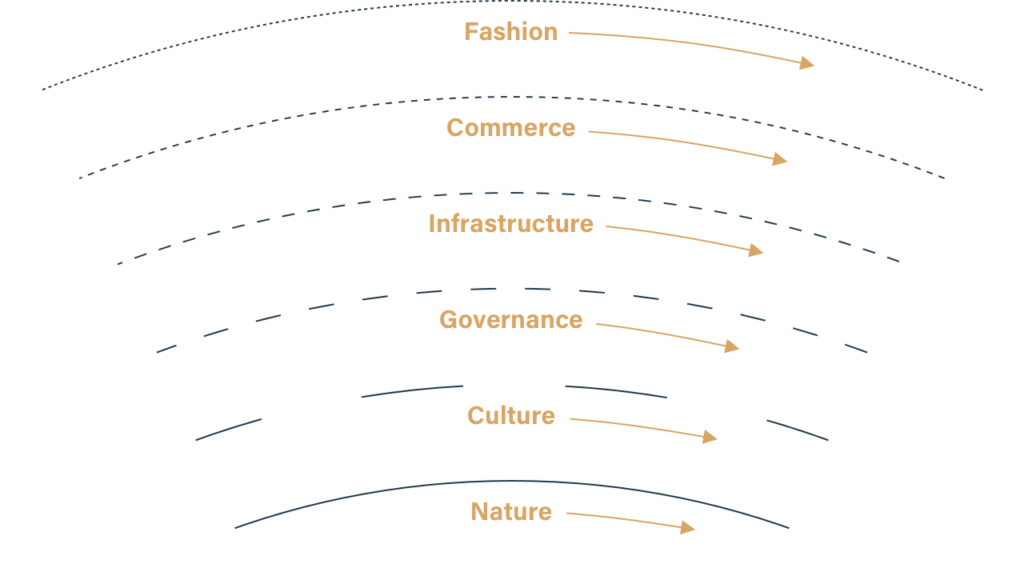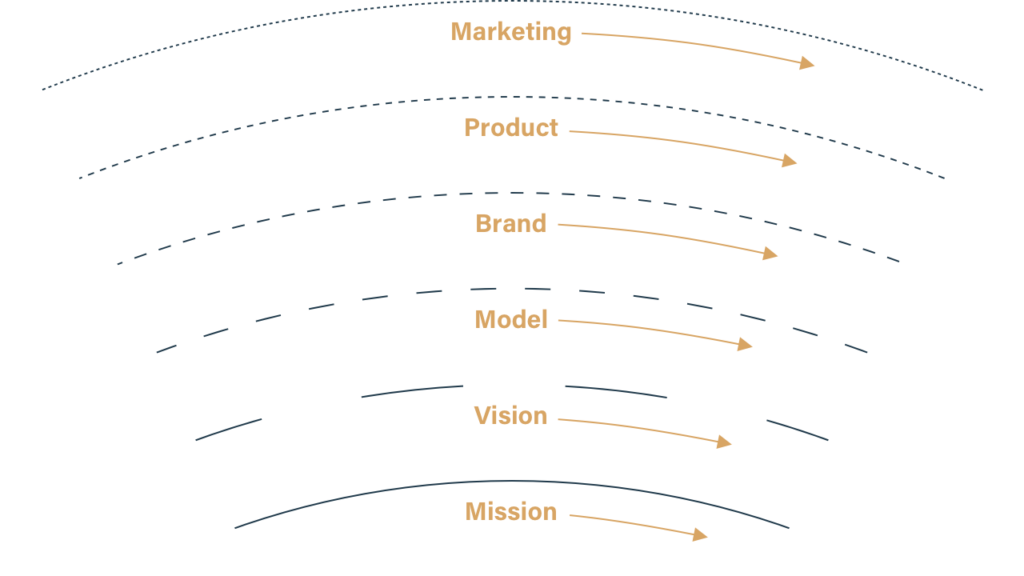Pace layering
Applying the learnings of complex systems to company strategy
The ability to grow and adapt while remaining on a continuous and non-destructive trajectory is a goal as old as time. It is something the systems around us have been forced to learn and embed within themselves – as the world spun through ice ages and natural disasters, as our species developed language or moved into the industrial age.
It is often said that the ability to learn is the most important skill one can possess, and that’s something that applies just as much to giant, complex systems as it does to the individual. It is what allows them to survive and thrive. Essential to this is ability to learn is experimentation – trialing new concepts and learning from them. From rainforest ecosystems developing to early humans grunting to communicate their desires, the introduction of a small new idea has the power to fundamentally change how systems as massive as our planet or our civilisation function.
A willingness to be open to new ideas is what leads to new discoveries. But in a world where many ideas will end in failure, that same willingness could easily lead a system down destructive paths if left unchecked. History is full of what could be considered failed experiments – extinct species, languages and empires. Many of them, the Roman empire for example, were great successes for a long time and left many important ideas and skills that still benefit the system of civilisation today. Many others were brief footnotes or catastrophic failures, often rejected by the repulsed system through force.
Importantly in both cases, the system is willing to move on – to avoid diminishing growth or to course correct its trajectory. The ability of these incredible complex systems to experiment and advance while remaining relatively stable is where an interesting concept lies: Pace Layering.
A blueprint for how systems learn, Pace Layering (a concept I came across in Stewart Brand’s excellent article on the subject) proposes that systems are built of varying layers.
The inner-most of these are the most slow moving and change only on long timeframes. The outer layers move quickly and change constantly. These outer layers are where experimentation happens, they are constantly adapting to their environment and try new things with relative freedom.
The layer immediately below learns from them, but due to its slower pace is somewhat resistant to. Only changes that stand the test of time in outer layers are absorbed through the inner layers, so the system evolves while remaining relatively true to its inner-most values, goals and knowledge. It is at once adaptable and robust.

As Brand explains, the fast and slow layers compliment each other excellently in a balanced system…
| Fast… | Slow… |
| learns | remembers |
| proposes | disposes |
| is discontinuous | is continuous |
| instructs slow by accrued innovation and occasional revolution | controls fast by constraint and constancy |
| gets all of our attention | has all the power |
To take the structure of a civilisation as an example, he proposes 6 layers…

Fashion (which I take to include media and art) – the outer-most layer – is ruthlessly experimental. It trials ideas constantly and moves on from them quickly. Commerce below this adapts to include the most successful of these ideas, which in turn affects infrastructure and so on. The inner-most layers are resistant to change and enforce constraints on those above them – nature’s inability to accept our treatment of it being an illustration of this. In that way, layers need to respect the existence and pace of those above and below them – accepting their constraints and being open to their learnings.
Another benefit of this system is its ability to absorb shocks. The faster moving, outer layers react and accommodate change, allowing the system to bend rather than break under stress and the inner layers to remain unaffected.
As well as applying to the most gigantic systems, this is a concept that resonates just as strongly in smaller ones. On an individual level for example, we have a system of layers from our inner-most biology and basic needs through our intellectual capacity, values and interests to our fashions, jobs and daily activities. We go through our lives trialling things on our outer layers which inform who we eventually become.
The same can be said of companies. Whether we are aware of it or not, a system such as this already exists in the operation of a company. Our ability to more deeply understand this system should effect our effectiveness in considering and acting upon it.
From the perspective of a design strategist, I would propose six layers that form a company…

| Mission |
| The highest level goal of a company. This is the organisations reason to exist, the key beliefs that led to its formation. Some may be purely based on business and market needs – such as Disney’s ‘To be one of the world’s leading producers and providers of entertainment and information’ – while others may be more social – such as Tesla’s ‘to accelerate the world’s transition to sustainable energy’. They very rarely change, if ever, and define the company’s market, focus and aims. |
| Vision |
| At a slightly higher level, the vision is how the company plans to make their mission happen. Whether it’s by creating children’s films or selling electric vehicles, it contains what needs to happen for the company to move towards its mission in the near future. Importantly, it is more adaptable than mission, as the route to achieving the ultimate goal is likely to change with an ever-moving world and market. In their goal of transitioning the world to sustainable energy for example, Tesla may focus their vision on cars now but later down the line may offer a full-suite electric mobility subscription or shift their core focus to aviation |
| Model |
| The layer of business strategy, a company model aims to match its vision to market needs. To provide products that achieve its vision in a way the market is willing to consume them and at a rate that market is willing to pay. It may at one time be about manufacturing and selling cars directly to consumers, at another be focused on providing services to businesses or eventually converting infrastructure. There are often many business models being trialled or successfully running within a company’s overall model, and the success or failure of these will influence the company vision over time. |
| Brand |
| Above the model, a brand contains the core tenets of the way a company displays itself to the world. It is the personality of a company – how it communicates, looks, advertises and engages with the systems around it. It adapts to changing trends and markets as well as to the learnings of the products and marketing above it. Absorbing changes in its audience, these learnings might be fed down into the model in order to more effectively provide for these new circumstances. |
| Product |
| The products a company will offer are a result of the layers below them – what the company is trying to achieve, the business around doing this and the personality of the company. They are experimented upon, evolved and adapted to the market with regularity. New cars are launched for new audiences, new features are trialled and abandoned, upsell offerings are tweaked. Their success is evaluated (see BCG’s Portfolio Matrix for example) and the successes are absorbed further into brand and model while the failures are rejected or iterated upon. |
| Marketing & sales |
| At the outermost layer, a company will engage with its audience or potential audience in a multitude of ways. From advertising and mailing lists to focus groups and outbound sales, marketing will move incredibly rapidly to test audiences, ideas and messaging. It will constantly engage with the market and absorb the multitude of learnings that come from this. It may even test products, brand changes and models before they exist. It is the layer of the now, latching onto meme trends and current events to amplify its voice. Due to its transient nature, few of these experiments and changes are likely to move deeply down the company’s layers, but over time some of them come to influence the deepest tenets of a company’s existence. |
As in the system of civilisation, learnings and adaptations trickle down through these layers slowly and many do not move deeper into the system at all…

This is an empowering system for the ‘fail fast’ age of corporate strategy we are in. It allows marketing and product to move quickly and trial ideas free in the knowledge that their failures will not be absorbed too deeply through the company. By considering the system, we can allow it to do its job – that of protecting our deepest values and goals while allowing the company as a whole to adapt to top level and external influences.
It also provides a model for learning, a prompt for layers and company functions to consider the needs, constraints and successes of others.
Inner layers are encouraged to continuously absorb and analyse the successes and failures above them. A digital dashboard product may adapt it’s language based on marketing learnings above it, which might feed into the underlying brand tone of voice and eventually trigger a change in model – away from a pricing structure that enables ‘power’ and towards one that enables ‘convenience’ for example.
Outer layers are empowered to experiment with relative freedom but also encouraged to consider the constraints that exist below them – the audiences that may be out of bounds based on the company’s pricing model or the bad practices that would be in opposition to it’s brand values.
What’s more, a company can be absorbent of shocks. From small events such as a cultural wave that marketing rides without impacting the company brand to black swan events such as a global pandemic that may impact a company’s model without changing it’s vision and mission, the system can adapt to just the right level to survive negative changes and further thrive through those that contain opportunities.
As Brand puts it…
The total effect of the pace layers is that they provide a many-leveled corrective, stabilizing feedback throughout the system. It is precisely in the apparent contradictions between the pace layers that civilization finds its surest health.
Stewart Brand – Pace Layering: How complex systems learn and keep learning
| Footnote: For the wider reader, it is important to note that ‘Pace Layering’ is a concept that has separately been adapted as a structure for IT governance. It bares some similarities to what I outline above but has many fundamental differences and should not be conflated with what I aim to discuss. |
Want to make something happen?
Get in touch.